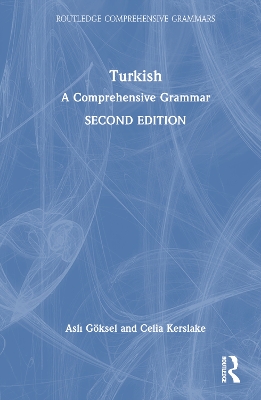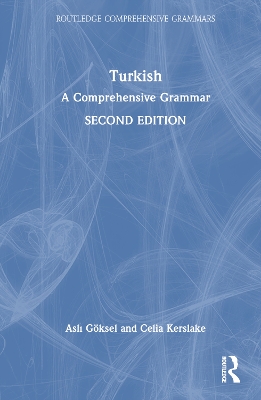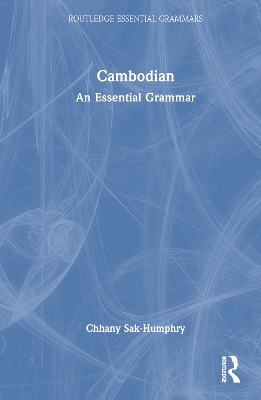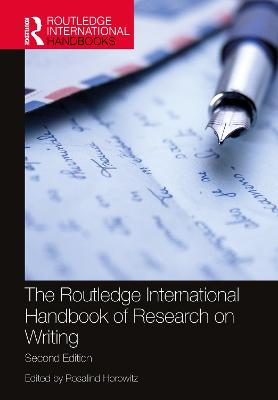Tondano (Toundano)
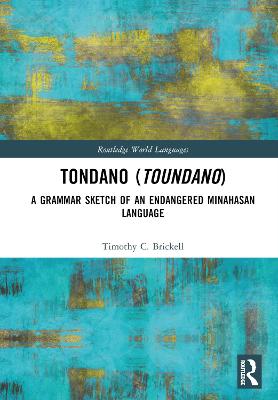 -10%
portes grátis
-10%
portes grátis
Tondano (Toundano)
A Grammar Sketch of an Endangered Minahasan Language
Brickell, Timothy C.
Taylor & Francis Ltd
12/2022
266
Dura
Inglês
9781138549975
15 a 20 dias
684
Descrição não disponível.
Contents
List of figures
List of tables
Acknowledgements
Abbreviations
1 Introduction
1.1 Minahasa: population, geography, and economy
1.2 History and culture of the region
1.2.1 Minahasa in pre-colonial times
1.2.2 Colonisation: the 1500s onwards
1.2.3 Minahasa in the modern age
1.3 The languages of North Sulawesi
1.3.1 Indigenous languages of North Sulawesi
1.3.2 The Minahasan micro-group
1.3.3 Languages of wider communication
1.3.4 Linguistic vitality
1.3.5 Community attitudes
1.3.6 Previous descriptive work and major sources
1.4 Fieldwork and the data corpus
2 Phonetics and phonology
2.1 Phoneme inventory
2.1.1 Evidence for phonemic contrasts: minimal pairs
2.2 Distribution and allophonic variation
2.2.1 Consonant phonemes
2.2.2 Oral plosives
2.2.3 Nasals
2.2.4 Glides
2.2.5 Liquids
2.2.6 Fricatives
2.2.7 Vowel phonemes
2.3 Syllable structure and phonotactics
2.3.1 Syllable structure
2.3.2 Consonant clusters
2.3.3 Vowel sequences
2.3.4 Syllable sequences
2.3.5 Stress assignment
2.4 Morphophonological processes
2.4.1 Nasal assimilation
2.4.2 Nasal substitution
2.4.3 Pseudo nasal substitution
2.4.4 Reduplication
2.4.5 Vowel deletion
2.4.6 Consonant deletion
2.4.7 Epenthesis .
3 Morphology and word formation
3.1 Words: phonological and grammatical
3.1.1 Phonological words
3.1.2 Grammatical words
3.2 Roots and stems
3.2.1 Roots
3.2.2 Stems
3.3 Inflection and derivation
3.4 Affixes
3.4.1 Prefixes
3.4.2 Infixes .
3.4.3 Suffixes
3.4.4 Circumfixes
3.4.5 Affix ordering
3.5 Clitics
3.5.1 Proclitics
3.5.2 Enclitics
3.5.3 Clitic ordering
4 Lexical categories
4.1 Lexical categories and morphosyntactic categories
4.2 Nouns
4.2.1 Common and proper nouns
4.2.2 Temporal nouns
4.2.3 Locative nouns
4.2.4 Nominalisation
4.3 Verbs
4.3.1 Monovalent verbs
4.3.2 Bivalent verbs
4.3.3 Modal auxiliary verbs
4.4 Pronouns
4.4.1 Independent pronouns
4.4.2 Proclitic pronouns
4.4.3 Enclitic pronouns
4.4.4 Non-specific referents anu and ano
4.5 Adverbs
4.5.1 Degree adverbs
4.5.2 Focussing adverbs
4.5.3 Evidential and epistemic adverbs
4.5.4 Temporal adverbs
4.6 Demonstratives
4.6.1 Demonstrative attributives
4.6.2 Demonstrative pronouns
4.7 Quantifiers (non-numeral)
4.8 Numerals
4.8.1 Simplex cardinal numerals
4.8.2 Complex cardinal numerals
4.8.3 Ordinal numerals
4.8.4 Fractions
4.8.5 Multiplicatives
4.9 Prepositions
4.10 Conjunctions
4.11 Particles
4.11.1 Interjections and exclamations
4.11.2 Directional particles =la, =mee, and =mi
4.11.3 Completive =mou and incompletive =pe'
4.11.4 Verbal particle nei
5 Basic morphosyntax
5.1 Grammatical relations and semantic roles
5.1.1 Nominative
5.1.2 Accusitive
5.1.3 Genitive
5.2 Transitivity
5.2.1 Intransitive clauses
5.2.2 Transitive clauses
5.3 Verbal clause structure
5.3.1 Actor voice clauses
5.3.2 Undergoer voice clauses
5.3.3 Topicalisation
5.4 Non-verbal clauses
5.4.1 Existential clauses
5.4.2 Equative and attributive clauses
5.5 Other clause types
5.5.1 Question formation
5.5.2 Negation and prohibitives
5.5.3 Imperatives and adhortatives
5.6 Noun phrases and prepositional phrases
5.6.1 Noun phrases
5.6.2 Phrase marking
5.6.3 Possession
5.6.4 Prepositional phrases
5.7 Complex clauses
5.7.1 Complex multi-verbal predicates
5.7.2 Coordination
5.7.3 Relative clauses
5.7.4 Adverbial clauses
5.7.5 Complement clauses
5.7.6 Indirect speech
6 Major verbal alternations 183
6.1 Voice marking
6.1.1 Morphosyntactic typology and alignment
6.1.2 Actore voice
6.1.3 Patient voice
6.1.4 Locative voice
6.1.5 Conveyance voice
6.2 Dynamic, Potentive, and Stative morphology
6.2.1 Dynamic pa-/peN-
6.2.2 Potentive ka-
6.2.3 Stative ka-
6.3 Tense, aspect, and mood
6.3.1 Tense
6.3.2 Aspect
6.3.3 Mood
6.4 Completive prefix paka-
6.5 Manner marking prefix kapa-
6.6 Causative prefix pa-
6.7 Reciprocal and comitative (mutual) suffix -an
6.8 Reflexives: sandiri, nu esa, and nu waya
6.9 Requestive prefix paki-
7 Example text 224
7.1 Collecting and cooking wate 'sago grubs'
Bibliography
List of figures
List of tables
Acknowledgements
Abbreviations
1 Introduction
1.1 Minahasa: population, geography, and economy
1.2 History and culture of the region
1.2.1 Minahasa in pre-colonial times
1.2.2 Colonisation: the 1500s onwards
1.2.3 Minahasa in the modern age
1.3 The languages of North Sulawesi
1.3.1 Indigenous languages of North Sulawesi
1.3.2 The Minahasan micro-group
1.3.3 Languages of wider communication
1.3.4 Linguistic vitality
1.3.5 Community attitudes
1.3.6 Previous descriptive work and major sources
1.4 Fieldwork and the data corpus
2 Phonetics and phonology
2.1 Phoneme inventory
2.1.1 Evidence for phonemic contrasts: minimal pairs
2.2 Distribution and allophonic variation
2.2.1 Consonant phonemes
2.2.2 Oral plosives
2.2.3 Nasals
2.2.4 Glides
2.2.5 Liquids
2.2.6 Fricatives
2.2.7 Vowel phonemes
2.3 Syllable structure and phonotactics
2.3.1 Syllable structure
2.3.2 Consonant clusters
2.3.3 Vowel sequences
2.3.4 Syllable sequences
2.3.5 Stress assignment
2.4 Morphophonological processes
2.4.1 Nasal assimilation
2.4.2 Nasal substitution
2.4.3 Pseudo nasal substitution
2.4.4 Reduplication
2.4.5 Vowel deletion
2.4.6 Consonant deletion
2.4.7 Epenthesis .
3 Morphology and word formation
3.1 Words: phonological and grammatical
3.1.1 Phonological words
3.1.2 Grammatical words
3.2 Roots and stems
3.2.1 Roots
3.2.2 Stems
3.3 Inflection and derivation
3.4 Affixes
3.4.1 Prefixes
3.4.2 Infixes .
3.4.3 Suffixes
3.4.4 Circumfixes
3.4.5 Affix ordering
3.5 Clitics
3.5.1 Proclitics
3.5.2 Enclitics
3.5.3 Clitic ordering
4 Lexical categories
4.1 Lexical categories and morphosyntactic categories
4.2 Nouns
4.2.1 Common and proper nouns
4.2.2 Temporal nouns
4.2.3 Locative nouns
4.2.4 Nominalisation
4.3 Verbs
4.3.1 Monovalent verbs
4.3.2 Bivalent verbs
4.3.3 Modal auxiliary verbs
4.4 Pronouns
4.4.1 Independent pronouns
4.4.2 Proclitic pronouns
4.4.3 Enclitic pronouns
4.4.4 Non-specific referents anu and ano
4.5 Adverbs
4.5.1 Degree adverbs
4.5.2 Focussing adverbs
4.5.3 Evidential and epistemic adverbs
4.5.4 Temporal adverbs
4.6 Demonstratives
4.6.1 Demonstrative attributives
4.6.2 Demonstrative pronouns
4.7 Quantifiers (non-numeral)
4.8 Numerals
4.8.1 Simplex cardinal numerals
4.8.2 Complex cardinal numerals
4.8.3 Ordinal numerals
4.8.4 Fractions
4.8.5 Multiplicatives
4.9 Prepositions
4.10 Conjunctions
4.11 Particles
4.11.1 Interjections and exclamations
4.11.2 Directional particles =la, =mee, and =mi
4.11.3 Completive =mou and incompletive =pe'
4.11.4 Verbal particle nei
5 Basic morphosyntax
5.1 Grammatical relations and semantic roles
5.1.1 Nominative
5.1.2 Accusitive
5.1.3 Genitive
5.2 Transitivity
5.2.1 Intransitive clauses
5.2.2 Transitive clauses
5.3 Verbal clause structure
5.3.1 Actor voice clauses
5.3.2 Undergoer voice clauses
5.3.3 Topicalisation
5.4 Non-verbal clauses
5.4.1 Existential clauses
5.4.2 Equative and attributive clauses
5.5 Other clause types
5.5.1 Question formation
5.5.2 Negation and prohibitives
5.5.3 Imperatives and adhortatives
5.6 Noun phrases and prepositional phrases
5.6.1 Noun phrases
5.6.2 Phrase marking
5.6.3 Possession
5.6.4 Prepositional phrases
5.7 Complex clauses
5.7.1 Complex multi-verbal predicates
5.7.2 Coordination
5.7.3 Relative clauses
5.7.4 Adverbial clauses
5.7.5 Complement clauses
5.7.6 Indirect speech
6 Major verbal alternations 183
6.1 Voice marking
6.1.1 Morphosyntactic typology and alignment
6.1.2 Actore voice
6.1.3 Patient voice
6.1.4 Locative voice
6.1.5 Conveyance voice
6.2 Dynamic, Potentive, and Stative morphology
6.2.1 Dynamic pa-/peN-
6.2.2 Potentive ka-
6.2.3 Stative ka-
6.3 Tense, aspect, and mood
6.3.1 Tense
6.3.2 Aspect
6.3.3 Mood
6.4 Completive prefix paka-
6.5 Manner marking prefix kapa-
6.6 Causative prefix pa-
6.7 Reciprocal and comitative (mutual) suffix -an
6.8 Reflexives: sandiri, nu esa, and nu waya
6.9 Requestive prefix paki-
7 Example text 224
7.1 Collecting and cooking wate 'sago grubs'
Bibliography
Este título pertence ao(s) assunto(s) indicados(s). Para ver outros títulos clique no assunto desejado.
Undergoer Voice;Sugar Palm Tree;Nom Argument;Sago Grubs;Transitive Clauses;Non-verbal Clauses;Voice Clauses;Actor Voice Clauses;Voice Affixes;Voice Marking;Phrase Markers;Intransitive Clauses;Semantic Roles;North Sulawesi;Glottal Plosive;Phonological Words;Bivalent Verbs;Word Final Position;Matrix Clause;Nasal Substitution;Nasal Assimilation;Grammatical Words;Word Medial Position;Enclitic Pronominals;Verbal Prefixes
Contents
List of figures
List of tables
Acknowledgements
Abbreviations
1 Introduction
1.1 Minahasa: population, geography, and economy
1.2 History and culture of the region
1.2.1 Minahasa in pre-colonial times
1.2.2 Colonisation: the 1500s onwards
1.2.3 Minahasa in the modern age
1.3 The languages of North Sulawesi
1.3.1 Indigenous languages of North Sulawesi
1.3.2 The Minahasan micro-group
1.3.3 Languages of wider communication
1.3.4 Linguistic vitality
1.3.5 Community attitudes
1.3.6 Previous descriptive work and major sources
1.4 Fieldwork and the data corpus
2 Phonetics and phonology
2.1 Phoneme inventory
2.1.1 Evidence for phonemic contrasts: minimal pairs
2.2 Distribution and allophonic variation
2.2.1 Consonant phonemes
2.2.2 Oral plosives
2.2.3 Nasals
2.2.4 Glides
2.2.5 Liquids
2.2.6 Fricatives
2.2.7 Vowel phonemes
2.3 Syllable structure and phonotactics
2.3.1 Syllable structure
2.3.2 Consonant clusters
2.3.3 Vowel sequences
2.3.4 Syllable sequences
2.3.5 Stress assignment
2.4 Morphophonological processes
2.4.1 Nasal assimilation
2.4.2 Nasal substitution
2.4.3 Pseudo nasal substitution
2.4.4 Reduplication
2.4.5 Vowel deletion
2.4.6 Consonant deletion
2.4.7 Epenthesis .
3 Morphology and word formation
3.1 Words: phonological and grammatical
3.1.1 Phonological words
3.1.2 Grammatical words
3.2 Roots and stems
3.2.1 Roots
3.2.2 Stems
3.3 Inflection and derivation
3.4 Affixes
3.4.1 Prefixes
3.4.2 Infixes .
3.4.3 Suffixes
3.4.4 Circumfixes
3.4.5 Affix ordering
3.5 Clitics
3.5.1 Proclitics
3.5.2 Enclitics
3.5.3 Clitic ordering
4 Lexical categories
4.1 Lexical categories and morphosyntactic categories
4.2 Nouns
4.2.1 Common and proper nouns
4.2.2 Temporal nouns
4.2.3 Locative nouns
4.2.4 Nominalisation
4.3 Verbs
4.3.1 Monovalent verbs
4.3.2 Bivalent verbs
4.3.3 Modal auxiliary verbs
4.4 Pronouns
4.4.1 Independent pronouns
4.4.2 Proclitic pronouns
4.4.3 Enclitic pronouns
4.4.4 Non-specific referents anu and ano
4.5 Adverbs
4.5.1 Degree adverbs
4.5.2 Focussing adverbs
4.5.3 Evidential and epistemic adverbs
4.5.4 Temporal adverbs
4.6 Demonstratives
4.6.1 Demonstrative attributives
4.6.2 Demonstrative pronouns
4.7 Quantifiers (non-numeral)
4.8 Numerals
4.8.1 Simplex cardinal numerals
4.8.2 Complex cardinal numerals
4.8.3 Ordinal numerals
4.8.4 Fractions
4.8.5 Multiplicatives
4.9 Prepositions
4.10 Conjunctions
4.11 Particles
4.11.1 Interjections and exclamations
4.11.2 Directional particles =la, =mee, and =mi
4.11.3 Completive =mou and incompletive =pe'
4.11.4 Verbal particle nei
5 Basic morphosyntax
5.1 Grammatical relations and semantic roles
5.1.1 Nominative
5.1.2 Accusitive
5.1.3 Genitive
5.2 Transitivity
5.2.1 Intransitive clauses
5.2.2 Transitive clauses
5.3 Verbal clause structure
5.3.1 Actor voice clauses
5.3.2 Undergoer voice clauses
5.3.3 Topicalisation
5.4 Non-verbal clauses
5.4.1 Existential clauses
5.4.2 Equative and attributive clauses
5.5 Other clause types
5.5.1 Question formation
5.5.2 Negation and prohibitives
5.5.3 Imperatives and adhortatives
5.6 Noun phrases and prepositional phrases
5.6.1 Noun phrases
5.6.2 Phrase marking
5.6.3 Possession
5.6.4 Prepositional phrases
5.7 Complex clauses
5.7.1 Complex multi-verbal predicates
5.7.2 Coordination
5.7.3 Relative clauses
5.7.4 Adverbial clauses
5.7.5 Complement clauses
5.7.6 Indirect speech
6 Major verbal alternations 183
6.1 Voice marking
6.1.1 Morphosyntactic typology and alignment
6.1.2 Actore voice
6.1.3 Patient voice
6.1.4 Locative voice
6.1.5 Conveyance voice
6.2 Dynamic, Potentive, and Stative morphology
6.2.1 Dynamic pa-/peN-
6.2.2 Potentive ka-
6.2.3 Stative ka-
6.3 Tense, aspect, and mood
6.3.1 Tense
6.3.2 Aspect
6.3.3 Mood
6.4 Completive prefix paka-
6.5 Manner marking prefix kapa-
6.6 Causative prefix pa-
6.7 Reciprocal and comitative (mutual) suffix -an
6.8 Reflexives: sandiri, nu esa, and nu waya
6.9 Requestive prefix paki-
7 Example text 224
7.1 Collecting and cooking wate 'sago grubs'
Bibliography
List of figures
List of tables
Acknowledgements
Abbreviations
1 Introduction
1.1 Minahasa: population, geography, and economy
1.2 History and culture of the region
1.2.1 Minahasa in pre-colonial times
1.2.2 Colonisation: the 1500s onwards
1.2.3 Minahasa in the modern age
1.3 The languages of North Sulawesi
1.3.1 Indigenous languages of North Sulawesi
1.3.2 The Minahasan micro-group
1.3.3 Languages of wider communication
1.3.4 Linguistic vitality
1.3.5 Community attitudes
1.3.6 Previous descriptive work and major sources
1.4 Fieldwork and the data corpus
2 Phonetics and phonology
2.1 Phoneme inventory
2.1.1 Evidence for phonemic contrasts: minimal pairs
2.2 Distribution and allophonic variation
2.2.1 Consonant phonemes
2.2.2 Oral plosives
2.2.3 Nasals
2.2.4 Glides
2.2.5 Liquids
2.2.6 Fricatives
2.2.7 Vowel phonemes
2.3 Syllable structure and phonotactics
2.3.1 Syllable structure
2.3.2 Consonant clusters
2.3.3 Vowel sequences
2.3.4 Syllable sequences
2.3.5 Stress assignment
2.4 Morphophonological processes
2.4.1 Nasal assimilation
2.4.2 Nasal substitution
2.4.3 Pseudo nasal substitution
2.4.4 Reduplication
2.4.5 Vowel deletion
2.4.6 Consonant deletion
2.4.7 Epenthesis .
3 Morphology and word formation
3.1 Words: phonological and grammatical
3.1.1 Phonological words
3.1.2 Grammatical words
3.2 Roots and stems
3.2.1 Roots
3.2.2 Stems
3.3 Inflection and derivation
3.4 Affixes
3.4.1 Prefixes
3.4.2 Infixes .
3.4.3 Suffixes
3.4.4 Circumfixes
3.4.5 Affix ordering
3.5 Clitics
3.5.1 Proclitics
3.5.2 Enclitics
3.5.3 Clitic ordering
4 Lexical categories
4.1 Lexical categories and morphosyntactic categories
4.2 Nouns
4.2.1 Common and proper nouns
4.2.2 Temporal nouns
4.2.3 Locative nouns
4.2.4 Nominalisation
4.3 Verbs
4.3.1 Monovalent verbs
4.3.2 Bivalent verbs
4.3.3 Modal auxiliary verbs
4.4 Pronouns
4.4.1 Independent pronouns
4.4.2 Proclitic pronouns
4.4.3 Enclitic pronouns
4.4.4 Non-specific referents anu and ano
4.5 Adverbs
4.5.1 Degree adverbs
4.5.2 Focussing adverbs
4.5.3 Evidential and epistemic adverbs
4.5.4 Temporal adverbs
4.6 Demonstratives
4.6.1 Demonstrative attributives
4.6.2 Demonstrative pronouns
4.7 Quantifiers (non-numeral)
4.8 Numerals
4.8.1 Simplex cardinal numerals
4.8.2 Complex cardinal numerals
4.8.3 Ordinal numerals
4.8.4 Fractions
4.8.5 Multiplicatives
4.9 Prepositions
4.10 Conjunctions
4.11 Particles
4.11.1 Interjections and exclamations
4.11.2 Directional particles =la, =mee, and =mi
4.11.3 Completive =mou and incompletive =pe'
4.11.4 Verbal particle nei
5 Basic morphosyntax
5.1 Grammatical relations and semantic roles
5.1.1 Nominative
5.1.2 Accusitive
5.1.3 Genitive
5.2 Transitivity
5.2.1 Intransitive clauses
5.2.2 Transitive clauses
5.3 Verbal clause structure
5.3.1 Actor voice clauses
5.3.2 Undergoer voice clauses
5.3.3 Topicalisation
5.4 Non-verbal clauses
5.4.1 Existential clauses
5.4.2 Equative and attributive clauses
5.5 Other clause types
5.5.1 Question formation
5.5.2 Negation and prohibitives
5.5.3 Imperatives and adhortatives
5.6 Noun phrases and prepositional phrases
5.6.1 Noun phrases
5.6.2 Phrase marking
5.6.3 Possession
5.6.4 Prepositional phrases
5.7 Complex clauses
5.7.1 Complex multi-verbal predicates
5.7.2 Coordination
5.7.3 Relative clauses
5.7.4 Adverbial clauses
5.7.5 Complement clauses
5.7.6 Indirect speech
6 Major verbal alternations 183
6.1 Voice marking
6.1.1 Morphosyntactic typology and alignment
6.1.2 Actore voice
6.1.3 Patient voice
6.1.4 Locative voice
6.1.5 Conveyance voice
6.2 Dynamic, Potentive, and Stative morphology
6.2.1 Dynamic pa-/peN-
6.2.2 Potentive ka-
6.2.3 Stative ka-
6.3 Tense, aspect, and mood
6.3.1 Tense
6.3.2 Aspect
6.3.3 Mood
6.4 Completive prefix paka-
6.5 Manner marking prefix kapa-
6.6 Causative prefix pa-
6.7 Reciprocal and comitative (mutual) suffix -an
6.8 Reflexives: sandiri, nu esa, and nu waya
6.9 Requestive prefix paki-
7 Example text 224
7.1 Collecting and cooking wate 'sago grubs'
Bibliography
Este título pertence ao(s) assunto(s) indicados(s). Para ver outros títulos clique no assunto desejado.
Undergoer Voice;Sugar Palm Tree;Nom Argument;Sago Grubs;Transitive Clauses;Non-verbal Clauses;Voice Clauses;Actor Voice Clauses;Voice Affixes;Voice Marking;Phrase Markers;Intransitive Clauses;Semantic Roles;North Sulawesi;Glottal Plosive;Phonological Words;Bivalent Verbs;Word Final Position;Matrix Clause;Nasal Substitution;Nasal Assimilation;Grammatical Words;Word Medial Position;Enclitic Pronominals;Verbal Prefixes

